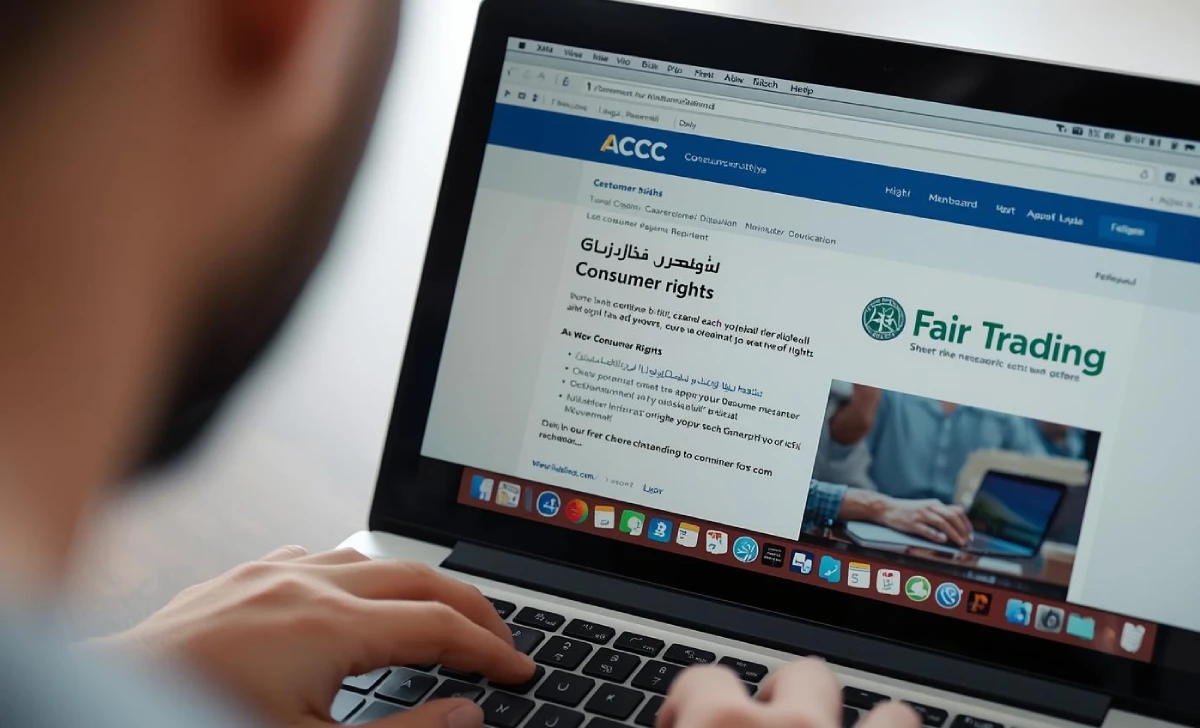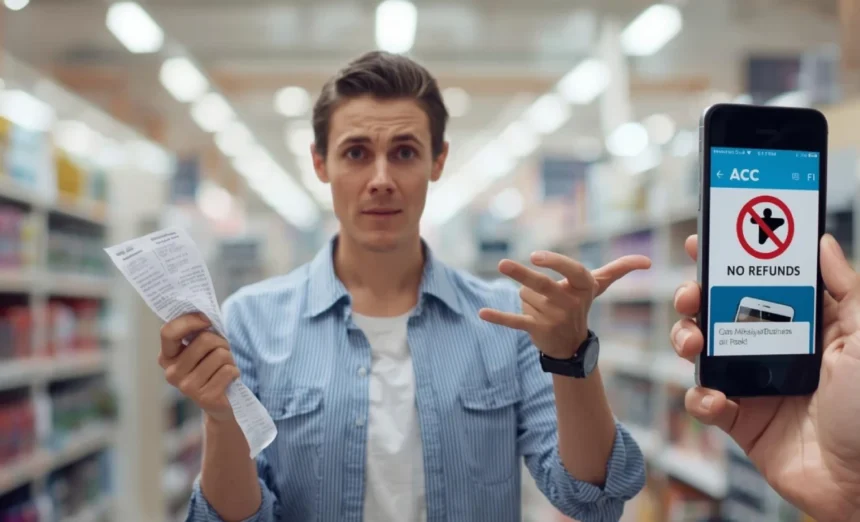When retailers make false claims about your return rights or warranty coverage, it can feel frustrating and confusing. Whether you’re told “no refunds on sale items” or that your warranty is void due to fine print you never saw, these misleading business practices in Australia are more common than you might think – but they’re also illegal under Australian Consumer Law.
- What the Australian Consumer Law Says About Returns, Refunds and Warranties
- How to Tell If a Retailer Is Lying or Misleading You
- First Steps: Contacting the Retailer and Drafting a Clear Dispute
- When to Contact ACCC vs Your State Fair Trading Office
- Small Claims and Tribunal Options: Taking Your Dispute Further
- Evidence Checklist and Timeline Tips to Maximise Success
- Conclusion
- FAQs
- Can a retailer refuse to give me a refund if the product is faulty?
- What’s the difference between a warranty and a consumer guarantee?
- What should I do first if I think a retailer is giving misleading information?
- When should I contact the ACCC and when should I contact my state/territory Fair Trading?
- What if the store’s website says “no refunds” or “no returns on sale items”?
- Do I have to go to small-claims court or a tribunal? What should I try first?
- Are there monetary limits for tribunal/small-claims cases?
The good news is that you have strong consumer rights and clear pathways to resolve these disputes. From crafting an effective complaint letter to knowing when to escalate to the ACCC or take your case to a consumer tribunal, this guide provides the practical steps you need to protect yourself and get the remedy you’re entitled to.
What the Australian Consumer Law Says About Returns, Refunds and Warranties
Under Australian Consumer Law (ACL), you have automatic consumer guarantees that no retailer can override, regardless of what their return policy states. These guarantees ensure that products must be of acceptable quality, fit for purpose, and match their description. When goods fail to meet these standards, you’re entitled to a remedy – and retailers cannot legally refuse this by claiming “store policy.”
The ACCC has been particularly active in addressing misleading business practices Australia-wide. In their recent enforcement sweep, companies like Koala and major automotive retailers were warned or fined for misleading customers about their return and warranty rights. Common violations included blanket “no refund” policies on sale items and incorrect claims about warranty limitations.
Consumer guarantees differ significantly from commercial warranties:
| Consumer Guarantees | Commercial Warranties |
|---|---|
| Automatic under ACL | Optional extra protection |
| Cannot be excluded | Can have terms and conditions |
| Cover major and minor failures | Usually covers specific defects only |
| Available for a reasonable time | Set time period only |
The key point is that consumer guarantees exist regardless of what a retailer’s policy states, and any attempt to limit or exclude these rights constitutes misleading conduct.
How to Tell If a Retailer Is Lying or Misleading You
Recognizing misleading practices is the first step to protecting your rights. Here are the most common red flags that indicate a retailer is providing false information:
Red Flag Checklist:
- “No refunds on sale items” signs (consumer guarantees still apply)
- Claims that manufacturer warranties are your only option
- Statements that minor faults don’t qualify for remedies
- Return policies that exclude certain product categories without legal basis
- Claims that you must pay return shipping for faulty goods
- “Final sale” terminology is used to avoid refund obligations
The ACCC’s recent investigation found that many retailers were using misleading website terms and conditions to discourage legitimate claims. Some businesses incorrectly stated that customers had no rights for items purchased during sales or clearance events.
Another common tactic is retailers claiming that normal wear and tear voids your consumer guarantee rights, when in fact, goods should last for a reasonable time under normal use conditions.
Quick Verification Tips:
- Screenshot misleading policies or statements
- Ask for written confirmation of any verbal claims
- Cross-reference retailer policies with ACCC guidance
- Don’t accept “company policy” as a reason to refuse your consumer guarantee rights
First Steps: Contacting the Retailer and Drafting a Clear Dispute
Before escalating to government bodies, Australian Consumer Law requires you to give the retailer a reasonable opportunity to resolve the issue. This contact process should be systematic and documented.
Initial Contact Steps:
- Phone the retailer first – note the date, time, and person you spoke with
- Clearly explain the fault and reference your consumer guarantee rights
- Request a specific remedy (refund, repair, or replacement)
- Follow up immediately with written communication
- Keep detailed records of all interactions
The ACCC recommends being clear, factual, and reasonable when contacting businesses about consumer guarantee issues. Avoid emotional language and focus on the specific fault and your legal entitlement to a remedy.
How to Craft an Effective Dispute Letter/Email
A well-structured complaint letter significantly improves your chances of a quick resolution. Here’s a proven template you can copy and adapt:
Subject: Consumer Guarantee Claim – [Your Name] – Order #[Number]
Dear [Store Manager/Customer Service],
I am writing to formally request a remedy under Australian Consumer Law for a faulty product purchased from your store.
Purchase Details:
- Date of purchase: [Date]
- Product: [Description and model]
- Price paid: $[Amount]
- Receipt/Order number: [Number]
Issue Description:
[Clearly describe the fault and when it occurred. Be specific about how the product fails to meet consumer guarantees.]
Remedy Requested:
Based on Australian Consumer Law, I am entitled to [choose: full refund/repair/replacement] as the product does not meet the consumer guarantee of acceptable quality.
Response Required:
Please confirm how you will resolve this matter within 7 business days. If this issue cannot be resolved directly, I will need to escalate to Fair Trading and/or the ACCC.
I look forward to your prompt response.
Regards, [Your name and contact details]
Phone Script and Evidence Collection
When calling, use this structure:
- “I purchased [product] on [date] and it has [specific fault]”
- “Under Australian Consumer Law, I’m entitled to a remedy as this breaches consumer guarantees.”
- “I’d like to arrange [refund/repair/replacement]. How can we resolve this?”
Evidence to Collect:
- Original receipt or proof of purchase
- Photos of the fault or damage
- Screenshots of misleading website policies
- Records of all communications with the retailer
When to Contact ACCC vs Your State Fair Trading Office
Understanding which authority handles your type of complaint ensures faster resolution and appropriate action.
Contact the ACCC when:
- The misleading practice affects customers nationally
- The retailer has a pattern of misleading conduct
- Website policies breach Australian Consumer Law broadly
- You suspect systematic violations across multiple locations
Contact State Fair Trading when:
- You need individual dispute resolution assistance
- The issue involves a local retailer
- You want mediation between you and the business
- You need advice about your specific situation
| ACCC Role | State Fair Trading Role |
|---|---|
| National law enforcement | Individual dispute resolution |
| Investigates widespread issues | Provides consumer advice |
| Takes court action for serious breaches | Mediates between parties |
| Policy development and guidance | Local business compliance |
The ACCC focuses on broader market issues and systemic breaches, while state and territory consumer affairs offices provide direct assistance with individual complaints and local enforcement.

Small Claims and Tribunal Options: Taking Your Dispute Further
When direct negotiation fails, consumer tribunals and small claims courts offer accessible legal remedies that do not require the involvement of lawyers.
Common Tribunal Options:
- NSW: NSW Civil and Administrative Tribunal (NCAT)
- QLD: Queensland Civil and Administrative Tribunal (QCAT)
- VIC: Victorian Civil and Administrative Tribunal (VCAT)
- WA: State Administrative Tribunal (SAT)
Typical Process Steps:
- Complete the online application form
- Pay the filing fee (usually $50-$200, depending on claim value)
- Submit evidence bundle
- Attend conciliation meeting (if offered)
- Present case at hearing if the conciliation fails
Monetary Limits by State (2024):
- NSW NCAT: Up to $40,000 for consumer claims
- QLD QCAT: Up to $25,000 for minor civil disputes
- VIC VCAT: Up to $40,000 for consumer affairs
- WA SAT: Up to $10,000 for minor cases
Most tribunals expect you to attempt resolution with the business before filing. Keep evidence of these attempts as they’re required for your application.
Success Tips:
- File promptly after dispute attempts fail
- Bring organised evidence bundles
- Focus on factual breaches of consumer guarantees
- Request specific remedies (refund amount, repair costs, replacement)
Evidence Checklist and Timeline Tips to Maximise Success
Strong evidence collection and prompt action significantly improve your chances of success, whether negotiating with retailers or presenting to tribunals.
Essential Evidence Checklist:
- ✓ Original receipt or proof of purchase
- ✓ Photos showing the fault or defect
- ✓ Screenshots of misleading website terms
- ✓ Email correspondence with the retailer
- ✓ Phone call logs with dates and names
- ✓ Product packaging and warranty information
- ✓ Independent expert assessment (for expensive items)
Timeline Considerations:
- Contact the retailer within a reasonable time of discovering the fault
- Most tribunals expect action within 12 months of the issue arising
- Keep detailed records from the first contact attempt
- Don’t delay filing tribunal claims if negotiation fails
What NOT to Do:
- Don’t delete any email correspondence
- Please don’t throw away faulty products before documenting them
- Don’t accept verbal promises without written confirmation
- Don’t wait months to address obvious faults
Cost Management Tips:
- Many community legal centers offer free consumer law advice
- Tribunal filing fees are typically recoverable if you win
- Consider the claim value versus the time investment for minor disputes
- Some consumer advocacy groups provide free assistance with evidence preparation
Conclusion
When facing misleading business practices in Australia, remember that you have strong legal protections under Australian Consumer Law. Start by contacting the retailer directly using the template provided, collect comprehensive evidence, and don’t hesitate to escalate to Fair Trading or the ACCC if needed. For serious disputes, consumer tribunals offer an accessible path to enforce your rights.
Your consumer guarantees cannot be overridden by store policies, and taking action protects not just your interests but also helps prevent these misleading business practices from affecting other consumers. Download our complaint letter template, gather your evidence, and take the first step toward resolving your dispute today.
Take Action Now: Use the dispute letter template above, document all interactions with the retailer, and report systematic misleading practices to help protect other Australian consumers from the same issues.
FAQs
Can a retailer refuse to give me a refund if the product is faulty?
No. If the product is faulty, not as described, or not fit for purpose, you have statutory rights under the Australian Consumer Law (ACL). That means you may be entitled to a refund, repair or replacement — retailers cannot contract out of these rights.
What’s the difference between a warranty and a consumer guarantee?
Consumer guarantees are automatic statutory rights under the ACL. A warranty (manufacturer’s or store warranty) is an extra promise from the seller or maker — it can offer additional benefits, but it cannot replace your statutory guarantees.
What should I do first if I think a retailer is giving misleading information?
Contact the retailer immediately: call, then follow up in writing (email/text). Keep your receipt, order number, photos of the fault, and any messages. Give the business a reasonable chance to resolve the problem before escalating.
When should I contact the ACCC and when should I contact my state/territory Fair Trading?
For an individual dispute, start with your state/territory Fair Trading (consumer affairs). Report to the ACCC when the issue appears systemic or affects many customers (e.g., misleading website-wide policies or repeated national breaches).
What if the store’s website says “no refunds” or “no returns on sale items”?
Blanket statements like “no refunds” cannot remove your ACL rights. Save a screenshot of the page and the URL, contact the retailer with your complaint, and escalate to Fair Trading or the ACCC if they refuse to comply.
Do I have to go to small-claims court or a tribunal? What should I try first?
Only if internal complaints and state consumer help don’t resolve it. Try the retailer’s complaints process, then Fair Trading; if that fails, you can consider a small-claims or consumer tribunal (e.g., NCAT, QCAT) — procedures and limits vary by state.
Are there monetary limits for tribunal/small-claims cases?
Yes — limits and names of tribunals differ across jurisdictions. Check your state or territory tribunal website for current claim thresholds and procedures before filing a claim.






